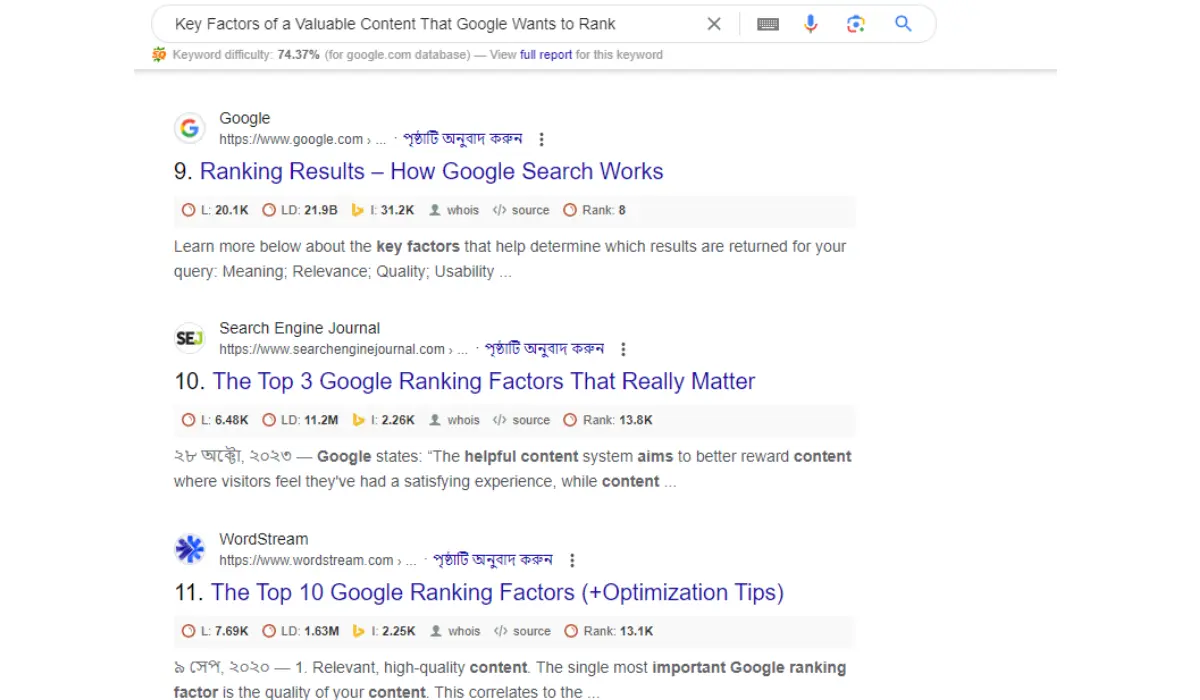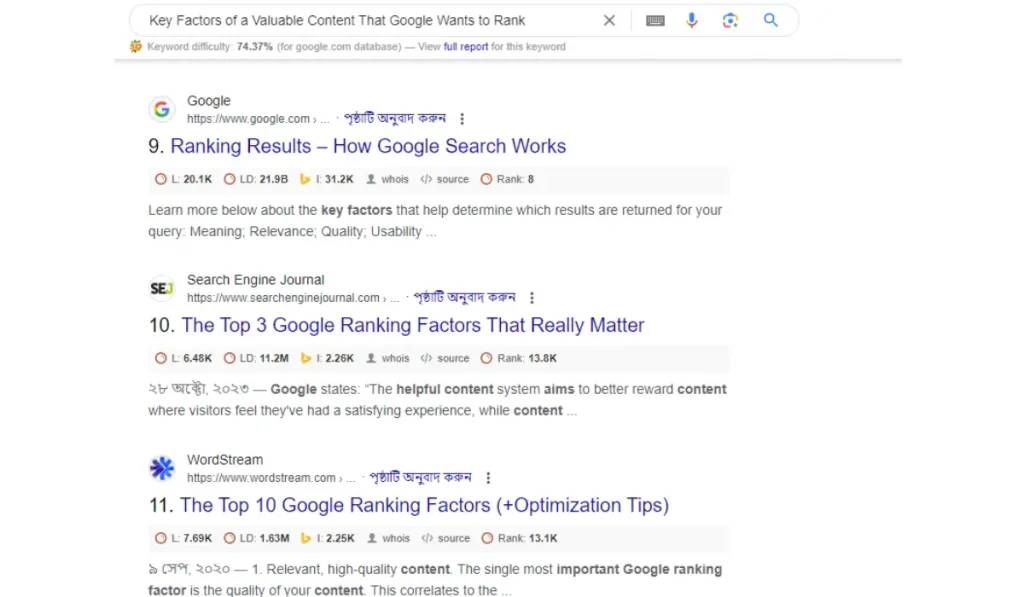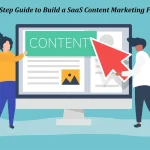Creating valuable content that ranks well on Google is a blend of art and science. As Google’s algorithms become more sophisticated, understanding what constitutes high-quality content is essential for anyone looking to improve their website’s visibility. Here are the key factors of valuable content in the eyes of Google:
Relevance and User Intent
Understanding relevance and user intent is fundamental for creating content that ranks well on Google. These factors ensure that the content you produce aligns with what users are searching for, thereby improving your chances of appearing higher in search results. Let’s delve into each of these aspects in detail.
Relevance
Relevance refers to how closely your content matches the search queries entered by users. Google evaluates the relevance of a page by examining several elements and it is one of the most important key factors of valuable content:
Keywords and Phrases:
Primary Keywords: These are the main terms that users search for. Incorporating primary keywords naturally into your content helps Google understand the topic of your page. For example, if users are searching for “best running shoes,” this phrase should appear in key locations such as the title, headings, and throughout the content.
LSI (Latent Semantic Indexing) Keywords: These are related terms and phrases that help Google understand the context of your content. For the “best running shoes” example, LSI keywords might include “athletic footwear,” “marathon shoes,” and “comfortable running shoes.”
Content Relevance:
Content Matching: Your content should directly address the query. If someone searches for “how to train for a marathon,” your article should provide detailed steps on marathon training rather than veering off-topic.
Freshness: In some cases, the relevance of content can be tied to its timeliness. For example, search queries related to technology or current events often favor the most recent content.
Meta Tags:
Title Tags: These should accurately reflect the content of your page. A well-crafted title tag includes primary keywords and is compelling enough to entice clicks.
Meta Descriptions: While not a direct ranking factor, a clear and relevant meta description can improve your click-through rate (CTR), signaling to Google that your content is valuable to users.
User Intent
User intent is the underlying goal or purpose behind a user’s search query. It is also very important key factors of valuable content. Understanding user intent helps in creating content that satisfies what users are looking for, thereby improving user satisfaction and increasing the chance of higher rankings. There are four primary types of user intent:
Informational Intent:
Objective: Users are seeking information or answers to specific questions.
Content Strategy: Provide comprehensive, well-researched, and easily digestible information. Examples include how-to guides, tutorials, and detailed articles. For instance, a query like “how to change a tire” would be best served with step-by-step instructions and visual aids.
Navigational Intent:
Objective: Users are looking for a specific website or page.
Content Strategy: Ensure your website and important pages are optimized for branded searches. For example, if someone searches for “Facebook login,” they are looking to navigate directly to Facebook’s login page.
Transactional Intent:
Objective: Users are ready to make a purchase or perform a specific online activity.
Content Strategy: Focus on conversion-optimized content that highlights product benefits, customer reviews, and clear calls to action. For example, a query like “buy iPhone 13” should lead to product pages with purchasing options, reviews, and comparisons.
Commercial Investigation:
Objective: Users are researching products or services before making a decision.
Content Strategy: Provide detailed comparisons, reviews, case studies, and buying guides. For example, a search like “best smartphones 2024” would benefit from a comprehensive comparison of the latest models, pros and cons, and expert reviews.
Aligning Content with User Intent
To effectively align your content with user intent, consider the following steps:
Keyword Research:
Use tools like Google Keyword Planner, SEMrush, or Ahrefs to identify keywords that users are searching for. Analyze the intent behind these keywords to determine what type of content to create.
Content Creation:
Tailor your content to match the identified user intent. For informational intent, focus on detailed articles and guides. For transactional intent, create product-focused pages with strong calls to action.
Content Structuring:
Organize your content in a way that is easy to navigate. Use headings (H1, H2, H3), bullet points, and short paragraphs to improve readability. This not only enhances user experience but also helps search engines understand your content better.
Analyzing Search Results:
Examine the top-ranking pages for your target keywords. Identify patterns in the type of content that ranks well and adapt your strategy accordingly. This can provide insights into what Google considers relevant for those queries.
User Feedback and Analytics:
Use tools like Google Analytics and Search Console to monitor how users interact with your content. High bounce rates and low dwell times can indicate that your content does not meet user expectations, prompting a need for adjustments.
Content Quality and Depth
Content quality and depth are critical factors that Google considers when ranking pages. High-quality, in-depth content not only meets user expectations but also helps establish your website as a trustworthy and authoritative source. Here’s an in-depth look at what constitutes high-quality content and how to achieve the necessary depth to rank well on Google.
Content Quality
Originality: Provide original perspectives and insights that aren’t available elsewhere. Google prioritizes content that adds new value to a topic.
Avoid Plagiarism: Ensure that your content is free from plagiarism. Using tools like Copyscape or Grammarly can help identify and correct duplicate content.
Accuracy and Reliability: Ensure that all information is accurate and up-to-date. Cite reputable sources and provide evidence to back up your claims.
References and Citations: Linking to authoritative sources not only enhances credibility but also provides additional value to readers.
Writing Quality: Write clearly and concisely. Use simple language and avoid jargon unless it’s essential to the topic.
Grammar and Spelling: Proofread your content to eliminate grammatical errors and typos. Tools like Hemingway Editor and Grammarly can assist with this.
User Engagement: Use images, videos, infographics, and other multimedia elements to make your content more engaging and visually appealing.
Interactive Content: Include elements like quizzes, polls, and interactive infographics to keep users engaged.
Content Depth
Comprehensive Coverage: Cover all aspects of a topic thoroughly. Anticipate and answer potential questions that users might have. For example, an article on “digital marketing” should cover various facets like SEO, content marketing, social media strategies, and analytics.
Subtopics and Sections: Break down complex topics into manageable sections or subtopics. Use headings (H2, H3, etc.) to structure your content logically and make it easier to navigate.
Length and Completeness: While there’s no strict rule on word count, longer, more comprehensive articles tend to rank better. Aim for a minimum of 1,500 words for in-depth articles, but ensure that every word adds value.
Avoid Fluff: Ensure that all content is relevant and necessary. Avoid adding unnecessary filler just to increase word count.
Supporting Information: Use data, statistics, and case studies to support your arguments. Visual representations like charts and graphs can make complex data easier to understand.
Examples and Case Studies: Provide real-world examples and case studies to illustrate your points. This not only adds depth but also makes your content more relatable and practical.
User-Centric Approach: Use tools like AnswerThePublic, SEMrush, or Ahrefs to find common questions related to your topic and make sure your content answers them.
User Feedback: Pay attention to user feedback and comments. This can give you insights into what additional information users are looking for.
Implementing Quality and Depth in Content Creation
Research Thoroughly: Spend time researching your topic comprehensively. Look at top-ranking pages, read authoritative books and articles, and gather a variety of perspectives.
Plan Your Content: Outline your content before you start writing. Identify the key points, subtopics, and structure of your article. This will ensure that you cover all necessary aspects and maintain a logical flow.
Use Visual Aids: Integrate images, videos, infographics, and other visual aids to enhance understanding and engagement. Visual content can break up text and make complex information more digestible.
Regular Updates: Content can become outdated over time. Regularly review and update your articles to ensure they remain accurate and relevant. This can also improve your search rankings, as Google favors fresh content.
Engage with Your Audience: Encourage comments and feedback. Respond to user questions and engage with your audience. This interaction can provide insights for further content development and show Google that your site is active and user-focused.
Examples of High-Quality, In-Depth Content
Ultimate Guides: Comprehensive guides that cover a topic from A to Z. These often include detailed explanations, step-by-step instructions, examples, and additional resources.
Long-Form Articles: Articles that delve deeply into a topic, often exceeding 2,000 words. These are typically well-researched, covering multiple aspects and providing a wealth of information.
Case Studies: Detailed examinations of specific cases, providing practical insights and lessons learned. Case studies often include data, analysis, and conclusions.
Research Reports: In-depth reports based on original research. These can include surveys, experiments, and extensive data analysis.
User Experience (UX)
User Experience (UX) plays a crucial role in determining how well your content ranks on Google. Good UX ensures that visitors find your site easy to use, engaging, and valuable. Google considers several UX factors when ranking pages, as they directly impact user satisfaction and engagement. Here’s a detailed look at the key elements of UX that affect Google rankings:
Readability and Accessibility
Readability: Use simple and straightforward language. Avoid jargon and overly complex sentences.
Formatting: Break up text with headings, bullet points, and short paragraphs to make content easier to read.
Font Size and Style: Use a readable font size and style. Ensure that text is easily legible on all devices.
Accessibility: Use descriptive alt text for images to help visually impaired users understand the content. This also helps search engines understand the context of images.
Keyboard Navigation: Ensure that your site can be navigated using a keyboard, as some users may not be able to use a mouse.
Screen Reader Compatibility: Make sure your website works well with screen readers by using proper HTML semantics and ARIA (Accessible Rich Internet Applications) attributes.
Mobile-Friendliness
Responsive Design: Your website should automatically adjust to different screen sizes and orientations. Use responsive design techniques to ensure a seamless experience across all devices.
Touch-Friendly Elements: Make sure buttons and links are easy to tap on mobile devices. Avoid small touch targets that can frustrate users.
Mobile Optimization: Mobile users often have slower internet connections. Optimize images and minimize code to ensure quick loading times on mobile.
Simplified Navigation: Use a mobile-friendly navigation menu. Consider a hamburger menu to save screen space and improve usability.
Page Speed
Loading Time: Reduce the number of elements on your page that require HTTP requests, such as images, scripts, and CSS files.
Optimize Images: Compress and resize images to reduce their load time without sacrificing quality.
Browser Caching: Enable browser caching to store static resources on the user’s device, reducing the need to reload these resources on subsequent visits.
Content Delivery Network (CDN): Use a CDN to serve content from servers closest to the user’s location, reducing latency.
Performance Metrics: Measures the time it takes for the largest visible element to load. Aim for LCP within 2.5 seconds.
First Input Delay (FID): Measures the time it takes for the page to become interactive. Aim for FID under 100 milliseconds.
Cumulative Layout Shift (CLS): Measures unexpected layout shifts during the loading phase. Aim for a CLS score of less than 0.1.
Engagement and Interactivity
User Engagement: Use videos, images, infographics, and other multimedia elements to make content more engaging. Interactive content like quizzes and polls can also enhance engagement.
Internal Linking: Provide links to related content on your site to keep users engaged and reduce bounce rates.
Interactivity: Include features like comment sections, social media sharing buttons, and interactive tools to encourage user interaction.
Feedback Mechanisms: Allow users to provide feedback on your content. This can help you identify areas for improvement and show users that their opinions are valued.
Navigation and Site Structure
Intuitive Navigation: Use a clear and intuitive menu structure to help users find what they’re looking for quickly.
Breadcrumbs: Implement breadcrumb navigation to help users understand their location within the site hierarchy.
Site Structure: Organize your content in a logical hierarchy, using categories and subcategories that make sense to users.
Sitemaps: Create XML sitemaps to help search engines crawl and index your site more effectively.
Trust and Security
Trust Signals: Include clear and accessible contact information and an “About” page to build trust with users.
Privacy Policy and Terms of Service: Provide easily accessible privacy policy and terms of service pages to assure users of their data protection and rights.
Security: Ensure your site is secured with HTTPS. This not only protects user data but also is a ranking factor for Google.
Data Protection: Implement measures to protect user data, such as secure forms and encrypted data storage.
Content Quality
Value-Driven Content: Ensure your content is relevant to the user’s query and provides valuable information.
Originality: Create original content that adds unique value. Avoid duplicating content from other sources.
Engagement Metrics: Measure the amount of time users spend on your page. Longer dwell times typically indicate that users find your content valuable.
Bounce Rate: Monitor the bounce rate to see how many users leave your site after viewing only one page. A high bounce rate can indicate that your content isn’t meeting user expectations.
4. Technical SEO
Page Speed: Fast-loading pages provide a better user experience and are favored by Google. Optimize images, use caching, and minimize unnecessary scripts to improve page speed.
Secure and Accessible Website: A secure (HTTPS) website is trusted by users and Google. Additionally, ensure your site is accessible to all users, including those with disabilities, by following web accessibility guidelines.
Structured Data: Implementing structured data (schema markup) helps Google understand the content on your site and can enhance your visibility with rich snippets.
5. On-Page SEO
Title Tags and Meta Descriptions: Craft compelling title tags and meta descriptions that include relevant keywords. These elements should accurately describe the content and entice users to click.
Header Tags: Use header tags (H1, H2, H3, etc.) to structure your content logically. Headers not only make content easier to read but also help search engines understand the hierarchy of information.
Internal Linking: Use internal links to guide users to related content on your site. This helps with site navigation and distributes page authority.
Also Read
6. Authority and Trustworthiness
Backlinks: High-quality backlinks from reputable websites signal to Google that your content is trustworthy and authoritative. Focus on building a diverse and natural backlink profile through quality content that others want to link to.
Experience, Expertise, Authoritativeness, and Trustworthiness (E-E-A-T): Demonstrating E-E-A-T is crucial, especially for YMYL (Your Money Your Life) content. Highlight author credentials, maintain up-to-date content, and ensure your website has a positive reputation.
7. User Signals
User signals are behavioral data that indicate how users interact with your website. Google uses these signals to gauge the quality and relevance of your content, impacting your search rankings. Understanding and optimizing for these user signals can significantly enhance your site’s performance. Here’s an in-depth look at the key user signals that influence Google rankings:
Click-Through Rate (CTR)
Definition: CTR is the percentage of users who click on your link when it appears in the search engine results page (SERP). It is calculated as (Number of Clicks / Number of Impressions) * 100.
Importance: A high CTR indicates that your listing is attractive and relevant to users. Google interprets this as a sign that your content matches user intent.
Optimization Tips: Write engaging and descriptive title tags that include your primary keywords.
Meta Descriptions: Craft persuasive meta descriptions that entice users to click. Although meta descriptions are not directly ranking factors, they can influence CTR.
Rich Snippets: Use schema markup to enhance your SERP listings with rich snippets, such as reviews, ratings, and FAQs, making them more appealing.
Dwell Time
Definition: Dwell time is the amount of time a user spends on your page before returning to the SERP. It reflects how engaging and valuable your content is to users.
Importance: Longer dwell times suggest that users find your content useful and engaging. Google considers this a positive signal of content quality.
Optimization Tips: Provide comprehensive, informative, and engaging content that meets user needs.
Multimedia: Incorporate images, videos, and infographics to make your content more engaging and visually appealing.
Readable Format: Use headings, bullet points, and short paragraphs to improve readability and keep users on your page longer.
Bounce Rate
Definition: Bounce rate is the percentage of visitors who leave your site after viewing only one page. A high bounce rate can indicate that users did not find what they were looking for.
Importance: While a high bounce rate is not always negative (e.g., single-page sites), it often suggests that your content or site experience did not meet user expectations.
Optimization Tips: Ensure your content matches the user’s search intent and provides value.
Internal Linking: Use internal links to guide users to related content, encouraging them to explore more pages.
Page Speed: Improve your page loading speed to reduce bounce rates due to slow loading times.
Pogo-Sticking
Definition: Pogo-sticking occurs when a user quickly returns to the SERP after clicking on a search result and then clicks on a different result.
Importance: Pogo-sticking indicates that the user did not find the initial result satisfactory. Google sees this as a negative signal regarding the relevance and quality of the content.
Optimization Tips: Ensure your content closely matches the search intent for your target keywords.
Content Quality: Provide high-quality, valuable content that answers the user’s query comprehensively.
User Experience: Improve the overall user experience by making your site easy to navigate and ensuring it loads quickly.
Return Visits
Definition: Return visits measure how often users return to your site after their initial visit. It indicates user loyalty and satisfaction.
Importance: High return visit rates suggest that users find your site valuable and worth revisiting. Google may interpret this as a sign of quality and relevance.
Optimization Tips: Regularly update your content to keep it fresh and relevant.
User Engagement: Encourage user engagement through comments, forums, or social media integration.
Email Marketing: Use email marketing to keep your audience informed about new content or updates, encouraging them to return to your site.
Pages Per Session
Definition: Pages per session measure the average number of pages a user views during a single session on your site.
Importance: More pages per session indicate that users find your site useful and are exploring multiple pages. This can be a positive signal to Google.
Optimization Tips: Strategically place internal links to guide users to other relevant content on your site.
Clear Navigation: Ensure your site’s navigation is intuitive and easy to use, helping users find related content.
Engaging Content: Create engaging and valuable content that encourages users to explore further.
Time on Page
Definition: Time on page measures the amount of time users spend on a particular page before moving on to another page or leaving the site.
Importance: Longer time on page indicates that users find the content engaging and useful. This can positively influence Google’s perception of your content’s quality.
Optimization Tips: Provide comprehensive and detailed content that keeps users engaged.
Multimedia and Interactive Elements: Use videos, images, and interactive elements to maintain user interest.
Clear Structure: Organize content with headings, subheadings, and other formatting tools to make it easier to read and follow.
Social Sharing and Engagement
Definition: Social signals refer to the likes, shares, and comments your content receives on social media platforms.
Importance: While social signals are not direct ranking factors, high social engagement can drive traffic to your site and indicate to Google that your content is valuable and engaging.
Optimization Tips: Create content that is likely to be shared on social media, such as insightful articles, infographics, and videos.
Social Sharing Buttons: Add social sharing buttons to your content to make it easy for users to share.
Engage with Audience: Actively engage with your audience on social media to foster community and encourage sharing.
Conclusion
Creating valuable content that Google wants to rank involves a holistic approach that combines relevance, quality, user experience, and technical optimization. By focusing on these key factors, you can create content that not only meets Google’s criteria but also provides significant value to your audience. Stay updated with the latest algorithm changes and continuously refine your strategies to maintain and improve your rankings.





